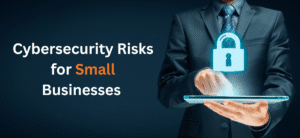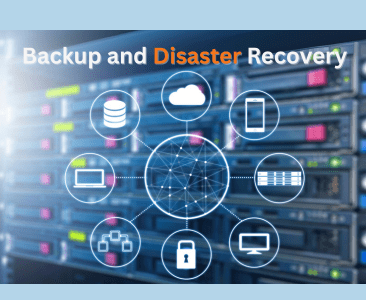In the ever-evolving digital landscape of 2025, small businesses face unprecedented challenges in safeguarding their operations. Cybersecurity Risks for Small Businesses have escalated dramatically, with cybercriminals targeting vulnerable entities that often lack robust defenses. According to recent studies, about 60% of small and medium-sized business (SMB) leaders now consider threats like phishing and ransomware as major concerns. This blog delves into the top 10 Cybersecurity Risks for Small Businesses, providing insights, examples, and practical prevention strategies to help owners mitigate these dangers. As cyber attacks become more sophisticated, understanding these Cybersecurity Risks for Small Businesses is crucial for survival and growth.
Small businesses are particularly attractive to hackers because they handle valuable data customer information, financial records, and intellectual property yet often operate with limited resources for security. In 2025, the rise of AI-driven attacks and remote work has amplified these Cybersecurity Risks for Small Businesses. Malware remains the most common attack type at 18%, followed closely by phishing at 17% and data breaches at 16%. By recognizing these threats early, entrepreneurs can implement cost-effective measures to protect their assets. Let’s explore the top Cybersecurity Risks for Small Businesses one by one.

1. Phishing Attacks
Phishing attacks top the list of Cybersecurity Risks for Small Businesses in 2025, as they exploit human error to gain unauthorized access. These deceptive emails or messages mimic legitimate sources, tricking employees into revealing sensitive information or clicking malicious links. In recent surveys, phishing accounts for 17% of attacks on SMBs, often leading to data theft or malware installation.
For small businesses, the impact can be devastating a single successful phishing attempt might compromise customer databases or financial systems. Consider a scenario where a retail shop owner receives an email purporting to be from a supplier, requesting updated payment details; unwittingly providing them could result in fraudulent transactions. With the integration of AI, phishing emails are becoming more personalized and harder to detect, making this one of the most persistent Cybersecurity Risks for Small Businesses.
To combat this, train employees on recognizing suspicious communications through regular workshops. Implement email filters and multi-factor authentication (MFA) to add layers of protection. Tools like antivirus software with phishing detection can scan incoming messages in real-time. By fostering a culture of vigilance, small businesses can significantly reduce their exposure to these Cybersecurity Risks for Small Businesses.
2. Ransomware
Ransomware continues to be a formidable among the Cybersecurity Risks for Small Businesses, encrypting files and demanding payment for decryption keys. In 2025, ransomware variants have evolved into “Ransomware 2.0,” which not only locks data but also threatens to leak it publicly if ransoms aren’t paid. This double extortion tactic has hit healthcare and manufacturing sectors hard, but small businesses are equally vulnerable due to weaker backups.
A typical attack might start via a phishing link, spreading through networks and halting operations. For instance, a small accounting firm could lose access to client records, facing downtime costs averaging thousands per hour. Reports indicate ransomware as a top threat, with incidents rising in critical infrastructure. These Cybersecurity Risks for Small Businesses often result in financial strain, with recovery expenses soaring.
Prevention involves regular data backups stored offline or in secure clouds, ensuring quick restoration without paying ransoms. Use endpoint detection and response (EDR) tools to monitor for anomalous behavior. Employee education on avoiding suspicious downloads is key, as is patching software vulnerabilities promptly to close entry points for these Cybersecurity Risks for Small Businesses.
3. Malware Infections
Malware, encompassing viruses, trojans, and spyware, ranks high in Cybersecurity Risks for Small Businesses by infiltrating systems to steal or damage data. At 18% of attacks, it’s the leading type for SMBs, often delivered through infected attachments or drive-by downloads.
Small businesses with outdated antivirus might fall prey easily; a café’s point-of-sale system infected with malware could leak credit card details, leading to lawsuits and lost trust. In 2025, malware is increasingly sophisticated, evading detection through polymorphic code that changes form.
Mitigation strategies include installing reputable antivirus software and enabling automatic updates. Conduct regular scans and restrict software installations to approved sources. By combining these with network segmentation, small businesses can limit malware spread, addressing one of the core Cybersecurity Risks for Small Businesses effectively.
4. Supply Chain Attacks
Supply chain attacks have surged as Cybersecurity Risks for Small Businesses, where hackers target third-party vendors to indirectly breach primary targets. In 2025, these attacks exploit software updates or services from suppliers, as seen in major incidents affecting global chains.
For a small e-commerce site relying on a payment processor, a compromised vendor could expose transaction data. This ripple effect amplifies risks, with small businesses often unaware of vulnerabilities in their ecosystem.
To counter this, vet suppliers thoroughly, requiring them to adhere to security standards. Implement zero-trust architectures that verify every access request. Regular audits of third-party integrations can help identify weaknesses, reducing the impact of these Cybersecurity Risks for Small Businesses.
5. Insider Threats
Insider threats, whether intentional or accidental, pose significant Cybersecurity Risks for Small Businesses in 2025. Disgruntled employees or careless staff might leak data or introduce vulnerabilities, with surveys highlighting this as a top concern.
An example is an employee sharing login credentials unknowingly via a phishing scam or deliberately selling company secrets. Small businesses, with fewer controls, suffer disproportionately from such breaches.
Prevention requires access controls based on least privilege principles, monitoring user activities for anomalies. Foster a positive work environment to minimize malice, and conduct exit interviews to revoke accesses promptly. These steps are essential in managing Cybersecurity Risks for Small Businesses from within.
6. Cloud Security Misconfigurations
As more small businesses migrate to the cloud, misconfigurations become critical Cybersecurity Risks for Small Businesses. Improper settings in platforms like AWS or Azure can expose data buckets publicly, leading to breaches.
A marketing firm storing client files without encryption might inadvertently allow global access, resulting in data theft. In 2025, with hybrid work models, these errors are common due to rushed setups.
Best practices include using cloud security posture management (CSPM) tools for automated checks. Train IT staff on configuration best practices and enable logging for quick issue detection. Addressing these Cybersecurity Risks for Small Businesses ensures safe cloud utilization.
7. AI-Powered Cyber Attacks
AI-powered attacks are emerging as novel Cybersecurity Risks for Small Businesses, where machine learning enhances phishing, malware, or deepfakes for deception.
Hackers use AI to craft convincing voice clones for fraud or automate vulnerability scanning. A small tech startup might receive a deepfake video from a “CEO” authorizing a wire transfer, leading to losses.
Countermeasures involve AI-driven defenses like anomaly detection systems. Stay updated on AI threats through industry forums and integrate behavioral analytics. This proactive approach is vital for navigating these advanced Cybersecurity Risks for Small Businesses.

8. Business Email Compromise (BEC)
Business Email Compromise (BEC) scams are prevalent Cybersecurity Risks for Small Businesses, involving spoofed emails to trick recipients into transferring funds or data.
In 2025, with remote teams, verifying requests is harder; a finance department might wire money based on a forged executive email. Losses from BEC can cripple small operations.
Mitigate by verifying high-value requests via secondary channels, like phone calls. Use domain-based message authentication (DMARC) to prevent spoofing. Employee awareness training reinforces defenses against these Cybersecurity Risks for Small Businesses.
9. DDoS Attacks
Distributed Denial of Service (DDoS) attacks overwhelm websites with traffic, causing downtime a key among Cybersecurity Risks for Small Businesses. At 12% of incidents, they target online stores, disrupting sales during peak times.
A boutique e-shop hit by DDoS might lose revenue and customer trust. In 2025, botnets powered by IoT devices amplify these attacks.
Protection includes using content delivery networks (CDNs) with DDoS mitigation and monitoring traffic patterns. Backup hosting options ensure continuity, helping small businesses weather these Cybersecurity Risks for Small Businesses.
10. IoT Vulnerabilities
Internet of Things (IoT) devices introduce Cybersecurity Risks for Small Businesses through unsecured smart gadgets like cameras or printers.
In 2025, with more connected offices, default passwords on IoT can serve as entry points for networks. A hacked thermostat could pivot to steal data.
Secure by changing default credentials, segmenting IoT on separate networks, and applying firmware updates. Regular vulnerability scans minimize risks from these expanding Cybersecurity Risks for Small Businesses.
Conclusion
In summary, the top 10 Cybersecurity Risks for Small Businesses in 2025 from phishing to IoT vulnerabilities underscore the need for proactive security measures. Small businesses must prioritize training, technology, and vigilance to thrive amid these threats. Ignoring these Cybersecurity Risks for Small Businesses could lead to irreparable damage, but with the right strategies, resilience is achievable.
To safeguard your enterprise against these Cybersecurity Risks for Small Businesses, visit vGics Global today for comprehensive cybersecurity solutions tailored to small businesses. Contact their experts for a free assessment and take the first step toward a secure future.























